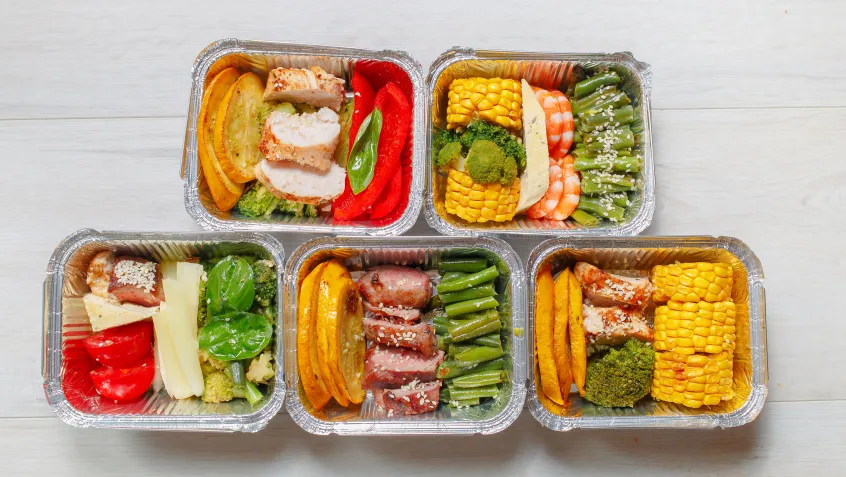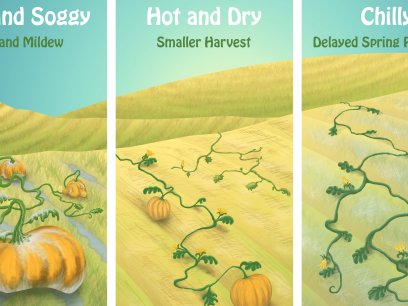
Are you leaving money on the table? How about fertilizer, water, or gas? According to the US Department of Agriculture, there might be more left on your tables, counters, and in your crisper drawers than you think.
The USDA Economic Research Service calculated that in 2010, almost one-third of the 430 billion pounds of food available for consumption at the retail and consumer levels in the United States was lost. It didn’t go missing—food loss is defined as the amount of food “available for consumption” (that is, food produced for people to eat excluding exports and non-edible parts such as bones or pits) that is not consumed. This amounted to 133 billion pounds of food—valued at $162 billion dollars—that were grown, harvested, and brought to places like grocery stores, restaurants, concession stands, schools, and homes, only to be lost to such factors as mold, pests, and waste. Food waste is a specific subgroup of food loss—while loss includes factors that we can’t always control, such as moisture loss and decomposition, food waste refers specifically to edible food that is discarded due to its appearance (such as bruised produce), taste, or plate waste after a meal.
When food loss occurs, it isn’t just a loaf of moldy bread going in the trash, or the leftovers from dinner being scraped into the garbage—this loss has a ripple effect on the environment. Behind that food is all of the time, labor, water, gasoline, and fertilizer used to produce the food and bring it to consumers, so when this food is not consumed, the nutrients, water, fuel, and time and energy used to create the food are also wasted. Globally, food loss is contributing to the estimated loss of more than 260 trillion gallons of water per year, or enough to fill Lake Erie about eight times. More locally, EPA estimates that in the United States, more food reaches landfills and incinerators than any other single material in our everyday trash. Once in a landfill, the nutrients from this this organic material are trapped, and unable to return to the soil. As the food rots, it emits methane gas, a greenhouse gas with an impact on climate change more than 25 times greater than that of carbon dioxide.
In 2010, more food loss occurred at the consumer level than with retailers. You can help combat food waste from your kitchen counter by cutting down on food loss during the feast. Here are some strategies to help:
- Buy only what you need. Come up with a realistic meal plan for your household for the week, and stick to your list to help save you money and reduce your food waste. Use this resource from EPA for more tips on how to shop smart.
- Understand package labels. Check out this resource from USDA on the difference between “Use by,” “Sell by,” “Best before,” and what these labels mean for food safety and shelf life.
- Use your freezer! Keep your food fresh longer by freezing anything you can’t eat in the next few days. This resource from the USDA tells you how to make the most of your freezer.
- Mold: proceed with caution. Think of mold as a “yellow light”—slow down before throwing the food away or eating it immediately. USDA has a list of which food items can still be salvaged after experiencing mold, and which are unsafe at first sight of these spores.
- Is this still good? Your leftovers have been in the fridge for a few days—are they still safe to eat? This chart from USDA tells you when to say goodbye to refrigerated foods.
- Spread the wealth! In 2017, 11.8% of US households—15 million total—had difficulty providing enough food to all members of their family at some point in the year. If you have non-perishable items in your pantry that you do not have a plan to eat, bring them to a local food bank.
- Compost. If you’ve reduced your extraneous purchases by shopping smart, made the most of your groceries with savvy food storage, and you’re still facing perishable food scraps, consider composting them so their nutrients can return to the soil and help grow more food for the future. This guide from EPA shows you how to get started.
Sources:
- Buzby, Jean C., Hodan Farah Wells, and Jaspreet Aulakh. 2014. “Food Loss—Questions About the Amount and Causes Still Remains.” Amber Waves. USDA ERS. Accessed November 17, 2015. http://www.ers.usda.gov/amber-waves/2014-june/food-loss%E2%80%94questions-about-the-amount-and-causes-still-remain
- Coleman-Jensen, Alisha, Matthew P Rabbitt, Christian Gregory, and Anita Singh. 2018. Household Food Security in the United States in 2017. ERR-256. US Department of Agriculture, Economic Research Service. https://www.ers.usda.gov/webdocs/publications/90023/err-256.pdf?v=0
- Ramaswamy, Sonny. 2014. “Happy Holidays…Waste Not, Want Not!” USDA Blog. USDA. Accessed November 17, 2015. http://blogs.usda.gov/2014/12/05/happy-holidays-waste-not-want-not/
- US EPA. 2015. “Overview of Greenhouse Gases.” Accessed November 17. http://www3.epa.gov/climatechange/ghgemissions/gases/ch4.html
- US EPA. 2015. “Sustainable Management of Food Basics.” Accessed November 17. http://www2.epa.gov/sustainable-management-food/sustainable-management-food-basics#what
- USDA ERS. 2015. “Food Availability Documentation.” Accessed November 17. http://www.ers.usda.gov/data-products/food-availability-%28per-capita%29-data-system/food-availability-documentation.aspx
- USDA ERS. 2015. “Loss-Adjusted Availability Documentation.” Accessed November 17. http://www.ers.usda.gov/data-products/food-availability-%28per-capita%29-data-system/loss-adjusted-food-availability-documentation.aspx


